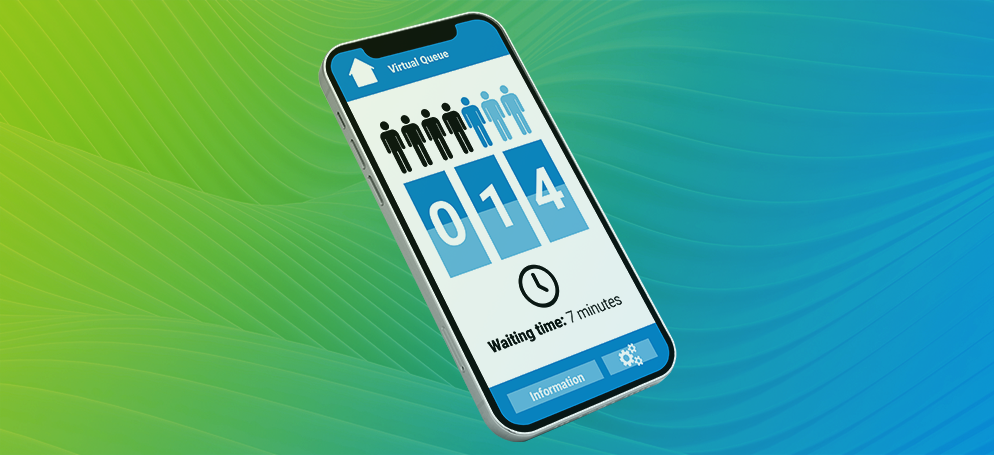
Is virtual queuing here to stay?
Over the last year, the pandemic has accelerated e-commerce growth for both omnichannel and pureplay retailers. To cope with increased web traffic, and to ensure social distancing in physical locations, retailers have experimented with virtual queuing. But is it a passing fad or is it here to stay?
How does virtual queuing work?
On an e-commerce website, a virtual queue is a queue of website or app visitors that exists within a virtual waiting room. Companies use virtual queuing to control the flow of visitors on a website, to mitigate bottlenecks, avoid website failure, and ensure customers are treated fairly on a first come, first served basis.
In an omnichannel context, some companies have kiosks or tablets in their physical stores or venues to facilitate virtual queues. Others have a mobile app which allows customers to enter and manage their time in the queue.
Virtual queuing can also be combined with online chat or help systems so companies can communicate with customers via their preferred channel. Different touch points in the customer journey can be made virtual, including:
• Pre-arrival: Customers book appointments in advance
• Virtual check-in: For example, by scanning a QR code
• Waiting remotely: Customers can wait somewhere safe, whilst monitoring their places in the queue and receiving notifications when it is their turn to be served
• Post-arrival: Online survey for customer feedback
Virtual queues are also known as online queues, digital queues, digital lines or virtual lines.
Benefits of virtual queuing
Aside from helping with social distancing, virtual queuing provides a number of benefits:
Better data
Customers input data before joining a virtual queue. This data can be used for segmentation, retargeting and personalised marketing. For example, companies can ask customers the reason for their visit when they join the virtual queue to gain a better understanding of customer intent and enable better retargeting afterwards.
Improved customer experience
For omnichannel retailers, virtual queuing provides opportunities to turn the queue into a source of entertainment or information. For example, technology like Augmented Reality and Virtual Reality can be used to gamify the experience or create an alternate reality so that instead of being stood outside a store, customers are surrounded by art or on a tropical beach. For theme parks, the queue experience can be integrated into the attractions themselves.
Improved conversion rate
For retailers looking to integrate the physical and digital experience, virtual queuing can also increase conversion rate and basket size. Shoppers waiting in a queue or booking an in-store appointment have a higher purchase intent than shoppers who are simply browsing, whether in-store or online. Since the in-store experience becomes less stressful with virtual queuing – since numbers are controlled – customers may spend more time browsing and adding more items to their basket. Store teams have more time to focus on helping and advising these higher purchase intent shoppers, which boosts conversions and basket sizes even more.
Making the online wait feel worthwhile
Studies show that how people feel when they wait in a queue often matters more than the actual duration of the wait. Uncertain waits feel longer than finite waits, and unexplained waits feel longer than explained ones. Even when customers have a strong desire to purchase the product or experience they are queuing for, the waiting time can feel tedious unless they have distractions.
Online queues have an advantage over physical queues because customers are not limited by the need to stand in line. If virtual waiting rooms can notify visitors when it is their turn, customers can do other things to occupy their time while waiting. Adding a progress bar on the virtual waiting room can also show customers where they are on the buying journey.
Online retailers can also promote future events, upsell additional products, and embed videos or games to keep their waiting audience engaged.
Communicating with waiting visitors is crucial to set expectations. Time spent waiting in a queue can feel like a waste if customers don’t experience an informed wait. Shoppers are more likely to stay if they know why they are waiting and for how long they can expect to be in the virtual waiting room.
Virtual queuing examples
Tesco’s body imaging automated system
In Ireland, Tesco is trialling a high-tech automated queuing system using 3D body imaging to keep track of how many customers are in the store.
A digital kiosk at the front of the store shows how many shoppers are in the store at any one time and the maximum number allowed in. If the store is not already at capacity, customers will see signage inviting them to enter. If it is at capacity, then they will be asked to wait.
Although cameras are used for the body imaging, Tesco has said that there is no recognition or recording elements to the system. Because cameras are prevalent in retail stores already, this concept could be easier to roll out than others.
Disney and other theme parks
For the leisure and attractions industry, the use of virtual queuing allows visitors to buy other products and services while waiting as they are no longer required to stand in a physical queue. Theme parks around the world have experimented with virtual queuing for a while now, before the pandemic – Disney launched a virtual queue app for its Star Wars: Galaxy’s Edge Park attraction in 2019 for example.
However, post-Covid, these systems may become essential if theme parks and similar venues or attractions want to survive while also protecting their guests.
Recently, US theme park group Six Flags unveiled plans to reopen some of its locations with new health and safety measures including virtual queuing as well face masks, temperature checks, reduced attendance, mobile ordering, cashless transactions, social distancing and constant sanitisation.
Lidl’s WhatsApp chatbot
Lidl’s initiative is less a queuing system and more a way of preventing queues. It has created a WhatsApp-based chatbot for customers in Ireland to find out the quietest times to visit their local store.
Using the chatbot, customers can send a message with the date and time that they would like to go shopping. The chatbot will then use information about shopper behaviour to let the customer know if the store is usually busy (or not) at their chosen time/day. Shoppers can use this information to plan their visit. Customers already like to be able to check what items are in stock before they visit the store, so finding out wait times is a logical extension.
Telecommunications
Telecommunications companies have long taken advantage of virtual queues. From sales, like buying a new mobile phone, to support with an existing device, virtual queues have helped thousands of telecommunications locations improve their customer experience and keep stores feel orderly.
Banks
Banks can benefit from queuing systems which integrate with their existing appointment scheduling system. When used together, this technology allows banks to manage their appointment schedule and customer experience from start to finish.
Technology companies
Technology companies use virtual queues to help schedule demos. Often, these companies combine their queuing system with an appointment scheduling system. This ensures that customers have the option to wait in the virtual waiting room or choose to schedule an appointment at a time that is convenient for them.
Since Covid, many businesses such as restaurants, hairdressers and gyms have begun trialling virtual queues to stay on top of their customer flow and reduce
walkaways. Additionally, most if not all contact centres use some form of virtual queueing to stay on top of their inbound calls.
Cultural attitudes to queuing
According to stereotype, queueing is quintessentially British – the irony being, of course, that the word “queue” is French. The strictest queuing etiquette tends to appear in more individualistic societies – such as the UK, Europe and USA – where people tend to be more highly sensitive to apparent inequality between people. Overall, though, cultural differences when it comes to queuing are not as marked as people sometimes imagine.
That said, there is some variation between countries. In Spain and other Latin countries, for example, people entering a café might ask “¿Quién es último?” (“who’s last?”) to establish their turn, rather than necessarily forming an orderly line – the disadvantage of this system being that it is harder to tell how long you will have to wait. Famously, the Chinese government tried to instil more orderly queuing habits amongst the population ahead of the Beijing Olympics, in order to impress international visitors.
. . .
Oban can help
Whilst Covid-19 has accelerated e-commerce innovation, many solutions such as virtual queuing are applicable during normal times as well. As ever, the challenge for e-commerce is to provide the best possible customer experience, tailored to local audiences. To find out how Oban can help you achieve that across markets, please get in touch.

Suzie Oakford | Commercial Director
Oban International is the digital marketing agency specialising in international expansion. Our LIME (Local In-Market Expert) Network provides up to date cultural input and insights from over 80 markets around the world, helping clients realise the best marketing opportunities and avoid the costliest mistakes.